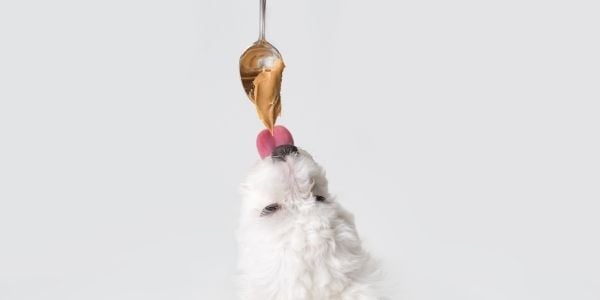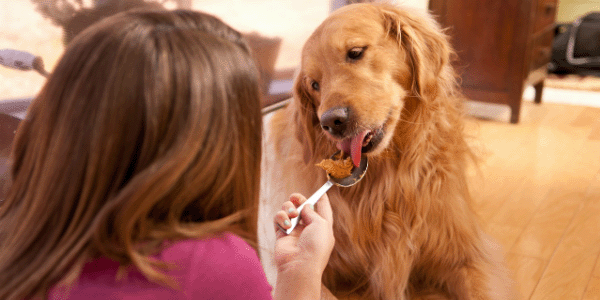
I personally have a serious weakness when it comes to peanut butter, especially the crunchy kind! I literally have at least two to three containers (think Costco size) on hand ALL the time. I know I am not the only one obsessed with it. In fact, in 2020, 299.34 million Americans consumed peanut butter.
So naturally, when we love eating something, and it is readily available in our cabinet, we want to share it with our best buddy.
The question is, should we or shouldn’t we share our PB with our dogs? The answer is generally yes, but there are some exceptions. Let’s explore when and when not to share!
Skip to section:
- Is peanut butter safe for dogs?
- Pet-safe peanut butter brands
- Peanut butter can cause illness or allergies in some dogs
- When NEVER to give peanut butter to your dog
- How much peanut butter is OK for a dog?
- How to use peanut butter to hide dog medication
- Is peanut butter and jelly OK for dogs?
- Is almond butter, cashew butter, or Nutella safe for dogs?
Is It Safe to Give Peanut Butter to a Dog?
“Definitely… but!”
For the most part, peanut butter can be awesome for dogs, and most dogs LOVE it! But there are a few things you should be aware of before you give your dog peanut butter.
Here is the ‘definitely’ part!
Peanut butter is great as an occasional "high-value" treat, a handy way to sneak some pills into your pooch, something to stuff into an interactive puzzle, and it can even be used to distract your dog while giving them a bath or trimming their nails.
Generally speaking, any peanut butter that doesn’t contain xylitol, chocolate, or cacao/cocoa should be fine for a dog. It can be a good source of protein and healthy fat — in moderation, of course. However, some peanut butters are healthier than others.

A lot of peanut butter brands you find on the shelves contain preservatives, extra sugar, and flavorings that aren’t great for your dog to eat.
Your best bet is to find peanut butter (or other nut butter) that is low on or completely free of added salt, sugars, sugar substitutes, or other additives. Also, in order to limit the potential negatives of peanut butter, just limit the amount of peanut butter you give your dog.
See below for how much peanut butter is an appropriate serving for your dog.
 Safe Peanut Butter Brands for Dogs
Safe Peanut Butter Brands for Dogs
There are several natural peanut butters that are single or limited ingredients that you can find on Amazon or at your local grocery store – our favorites are listed below:
NOTE: Always read labels and ingredient lists carefully — ingredients change over time and please don't assume that "all-natural" or "no artificial sweeteners" on the front label means it'll be safe for your dog. Xylitol, which is toxic to dogs, is made from birch bark or corn and is technically an "all-natural" sweetener!
See in the section below which peanut and nut butter brands are dangerous for dogs.
DIY Peanut Butter
If you have a food processor handy and you’d like to tap into your inner Martha Stewart, you can mix up some homemade peanut butter or other nut/seed butters (check out this article on safe and unsafe nuts and seeds) at home. It will be healthier for your dog, and they won’t know the difference.
Peanut Butter Recipe for Dogs
- Roast about 1/4–1/3 of a cup of unsalted peanuts until they’re lightly brown
- With a food processor or sturdy blender, whip the peanuts until smooth
- Add a little oil to get the desired consistency
- You can even use animal-based oils, like fish oils, that are safe for dogs
- Vegetable, peanut, or olive oils are great as well
Here's a recipe for home-made almond butter that uses coconut oil, which has benefits for dogs (and people).
An alternative to homemade peanut or nut butters is sunbutter, made with sunflower seeds – here's an easy recipe to follow.
2 TBSP of peanut butter powder is 50 calories and contains 1.5g of fat.
2 TBSP of regular peanut butter is 190 calories and contains 16g of fat.

What About Peanut Butter Powder?
If you really want the yummy taste of peanut butter but your dog can’t afford to have the extra calories and fat of regular PB, you can consider using peanut butter powder. Personally, I love the stuff, especially when you consider two tablespoons of peanut butter powder is only 50 calories, and since most of the fat is removed, it only contains 1.5 grams, whereas regular PB is 190 calories and 16g of fat per two tablespoons. That’s a pretty big difference!
Plus, there is the added benefit of being able to make it as thick or thin as you want, and it blends great with yogurt to make special treats.
To use it, simply mix the powder with water and bam – yummy peanut butter!
Here are some options that only contain peanut flour/powder:
As with regular peanut butter, be sure to read the label to ensure that the product doesn’t contain xylitol, added sugar, or other additives.
Peanut Butter Can Cause Illness or Allergies for Some Dogs
As with anything, peanut butter should only be used in moderation if your dog is healthy, not overweight, and if you know which brands to avoid.
While dog-suitable peanut butter can be a wonderful source of protein and healthy fat for your dog, too much peanut butter can result in pancreatitis and obesity, so use sparingly if you're trying to help your dog lose weight.
NOTE: In dogs suffering from chronic pancreatitis or breeds predisposed to pancreatitis – like Miniature Schnauzers and Yorkshire Terriers – even a very small amount of a high-fat treat like peanut butter may be enough to bring on or worsen their pancreatitis and should be avoided completely.
It is important to be aware that for dogs with food allergies or on an “elimination trial” for suspected food allergies, peanut butter can possibly cause a food reaction or undermine the elimination trial.
Signs of a Chronic Food Allergy to Peanut Butter in Dogs
Even though it is uncommon for dogs to have peanut allergies (which can be common and severe in humans), it can happen in dogs but is usually a mild to moderate reaction. However, they can react severely (see below). It is less known how individual dogs respond to other nuts and seeds.
-
Chronic/recurrent ear infections
-
Thinning fur coat
-
Chronic itchiness and/or chewing of their paws
-
Recurrent problems with impacted anal glands
If it’s your dog’s first (or second) time having peanut butter or another nut butter, give them just a small amount to start (like a lick off the tip of your finger) and keep an eye on them.
Concerning signs to watch for are listed below. As long as you don’t see any of these signs within about an hour, you’re likely OK.
Signs of an Acute Allergic Reaction to Peanut Butter in Dogs
-
Hives or small areas of swelling on their body
-
Swelling around their eyes and/or muzzle
-
Severe itchiness
-
Rapid breathing or difficulty breathing
-
Vomiting
-
Diarrhea
-
Collapse
If any of these symptoms happen in your dog, seek veterinary medical care immediately.
When Peanut Butter Is Definitely a NO!
It is important to make sure your peanut butter does not contain xylitol. This “all-natural” sugar substitute is an increasingly common sugar-replacement sweetener in hundreds of products, including some brands of peanut butter. While it is safe for people, it’s extremely poisonous to dogs (even in small amounts) and poisons thousands of dogs each year.
The toxic dose of xylitol in dogs is even less than chocolate!

As little as 1.37 grams of xylitol, for example, can cause a rapid drop in a dog’s blood sugar (hypoglycemia) and result in staggering, disorientation, collapse, and seizures in a 30-pound dog.
If a dog of the same size ingested 6.8 grams, it could be enough to cause a debilitating and likely deadly destruction of the dog’s liver cells. Now consider that it would take about 22 times more (150 grams) of dark chocolate to result in the same level of severe toxicity.
Brands of Peanut Butter That Contain Xylitol and Are Not Safe for Dogs
Here are some known peanut/nut butter brands that contain xylitol, and more may spring up — so please read labels carefully.
-
Go Nuts, Co. (appears to no longer be in business)
-
Krush Nutrition (appears to no longer be in business)
-
Nuts 'N More
In 2015, we were in discussions with Nuts ’N More and they have agreed to take some good initial steps to improve awareness of the hazard that xylitol poses to dogs. They have added a new warning about the dangers of xylitol to dogs in the "What Is Xylitol?" section of their FAQ page (though note that there truly is no “maybe” about it; xylitol IS dangerous to dogs).
-
P28
We at Preventive Vet are happy to report that there has been an increase in awareness about xylitol – both in peanut butter and in the more than 700 other products xylitol is found in – and we have been able to influence some companies to change their labeling and warning practices. NOTE: If you find a brand that contains xylitol that isn’t on our list, please share so we can spread the news.
On August 3, 2017, we received a message from Hank Capasso of Hank’s Protein Plus Nut Spreads, announcing that he had taken the wonderful step of removing xylitol from his company’s peanut and other nut butters.
“I have always been an animal lover, never to the extent of being an advocate for the rights of animals, until recently,” Hank wrote in the closing of that letter. “In doing my research and in making myself open to their rights, it only makes sense. Why put them in danger, and why would we hurt the ones that we love?”
We have checked their labels to confirm that their nut butters no longer contain xylitol and have removed them from our list of xylitol-containing products. We thank the team at Hank’s Protein Plus Nut Spreads for taking this fantastic step toward protecting dogs from the dangers of xylitol.
Peanut butter powders are growing in popularity since they contain less fat and calories. But, just like with spreadable peanut butter, be sure to check their label for xylitol.
NOTE: Peanut butter powders with vanilla powder or vanilla sweeteners may contain xylitol. Therefore, do not use products with these ingredients. Also avoid any that contain cacao, cocoa, or any form of chocolate.
How Much Peanut Butter Is OK for a Dog?
Disclaimer
This information should be taken as a general approximation, not a guide or recommendation for your specific dog’s daily calorie intake. There are many factors that impact a dog’s necessary calories, such as whether they’re neutered, their activity level, pregnancy, current body condition, diseases such as cancer, thyroid, and diabetes… just to name a few.Talk to your vet to determine how many calories per day your dog needs to maintain a healthy weight. And if you notice any change in your dog’s weight — either a gain or loss in weight — but haven’t changed their daily calories or exercise, it’s time to schedule a vet visit to determine the underlying cause.
As with any treat, peanut butter should be a complement to your dog’s regular meals, not a replacement. As a general rule, do not give more than 10% of your dog’s daily calories in treats.
(Check out this dog treat calculator to figure out how many treats you can give your dog a day.)
For quick reference, here is a breakdown of how much peanut butter you can give to a normally active, healthy dog (approximately, based on the calories in most peanut butter with about 95 calories per tablespoon).
| Dog Weight |
Approx. amount of peanut butter per day |
| 20 lbs | 3/5 tbsp |
| 30 lbs | 1 tbsp |
| 50 lbs | 1 1/6 tbsp |

How to Give Your Dog Peanut Butter
The secret to giving your dog peanut butter is… well, there isn’t a secret. Stuff peanut butter into a food puzzle, such as a Kong toy. Put a blob of peanut butter in your dog’s bowl or spread it on a lick mat. Or just scoop some onto your finger.
Make your dog their own frozen peanut butter treats.
Peanut butter is particularly well suited to interactive feeders because A) your dog will really want to get out every last bit, and B) it will take them a while to extract every last bit. A Kong toy stuffed with peanut butter should keep your dog occupied for quite a while, and they’ll love every minute.
Bonus Tip: If your dog is especially wily when it comes to food puzzles and interactive feeders, try freezing the toy with the peanut butter inside to create a frozen treat that will keep them entertained even longer. Or freeze it in their bowl for even more of a challenge.
How to Use Peanut Butter to Hide Dog Pills
Anyone who’s tried to medicate a dog will quickly realize that dogs are brilliant at spitting out pills. The trick is to hide the pill in something they’ll quickly gulp down without realizing it was a Trojan Horse for medication.
Depending on your dog and the size of the pill, straight peanut butter can be a fantastic way to hide pills. Simply place the pill on a spoon with a little bit of peanut butter, spread a little more over the top of the pill, and voila!
But if your dog is an expert pill-locator, you’ll need to be slightly more cunning.
-
Take a small piece of bread, about the size of the end of your thumb, and spread peanut butter on one side.
-
Place the pill on the peanut butter.
-
Wash your hands to remove any pill residue on them.
-
Then, fold over either end to make a miniature sandwich.
When you give this to your dog, they’ll most likely chomp the whole thing down in one bite without realizing what you snuck inside.
If the medication is in a capsule, you can open the capsule, sprinkle the powder on a scoop of peanut butter, and mix them together well.
Tip: You can try ‘chunky’ peanut butter if you want to camouflage the texture of the pill or the grittiness of the powder.
Check out this article for more ideas on giving pills.
Is Peanut Butter and Jelly OK for Dogs?
Peanut butter is one thing, but jelly should be off-limits to your dog. First, there’s a lot of sugar in jam, jelly, and preserves — if you’re already giving your dog peanut butter, adding extra sugar will further increase the risk of obesity and diabetes. Second, some jelly contains dog-dangerous xylitol. Third, some types of jelly are made from fruits that you shouldn’t give your dog.
For example, while strawberry jelly may not be toxic to dogs, grape jelly can be.Grapes are poisonous to some dogs and can cause acute kidney failure. The same goes for raisins and currants.
Either way, it's best to hold the jelly and jam when it comes to treating your dog.
Is Almond Butter, Cashew Butter, or Nutella Safe for Dogs?
If peanuts aren’t really your thing, or perhaps you have an allergy to them, you’ve probably thought about giving your dog an alternative butter.
Almond butter, cashew butter, and sun butter are fine for dogs, though the latter are fattier than peanuts or almonds. You’ll have to take this into account to prevent obesity and other health issues, such as pancreatitis.
Just like with peanut butter, read the label to be sure that the product doesn’t contain xylitol or any other potentially toxic ingredients. Also, avoid those with added sugar or salt.
Note: While almonds, and just about any nut, can cause digestive upset, including pancreatitis, in dogs, contrary to what you may have read elsewhere on the Internet, regular (sweet) almonds, the type that are most common, are not toxic to dogs.
Now, bitter almonds, which can sometimes be found in health food stores, can certainly be toxic. So be sure to stick with sweet almonds when making this almond butter recipe and your dog (and you) should be just fine.
One special note about Nutella, if that’s your butter of choice: Don’t give Nutella to your dog. There are better and safer options.
Nutella contains a small amount of cocoa powder, i.e., chocolate, which is toxic to dogs in large enough quantities. Although a little bit of Nutella contains a small amount of cocoa and probably isn’t enough to do any major damage, it really depends on the size of your dog — plus, it’s just not worth the risk. Your dog will enjoy another non-chocolate option just as much.
If you do have Nutella in your house, make sure it is safely out of reach of your dog — on a tall shelf, behind a secure cabinet door, or in your belly. And be especially careful if you have cats, as they have a knack for knocking items off counters that your dog will happily “clean up.”
Let us know if you have any questions about peanut butter or related topics. Please remember to share with us if you find any peanut or nut butter products that contain xylitol.




